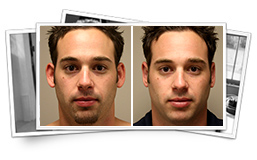Ear Pinning Thousand Oaks
Prominent, protruding ears can be an extremely bothersome feature, especially for young children who may be teased by other kids. This condition is present from birth, and is due to abnormal development and folding of the cartilage of the ear in-utero. Other congenital ear abnormalities can result in misshapen ears. These include Stahl’s ear, lop ear and cryptotia. Sometimes referred to as ear-pinning, an ear reshaping procedure, or otoplasty, is designed to address the abnormalities in the cartilage (and skin) of the ear and to restore the ears to a more normal shape and position.
Before & After Photos
 Ear Reshaping
Ear Reshaping
At the Kryger Institute of Plastic Surgery, we have experience in a vast array of surgical and non-surgical procedures. Click below to see some before and after photos of ear reshaping.
Who is a good candidate?
Children and adults with prominent ears, or any other abnormally appearing ears can be considered for ear reshaping surgery. Kids under the age of 6 should not undergo ear surgery. A good rule of thumb is that you should not think about surgery for your child until she begins complaining about her ears.
Does insurance cover ear reshaping surgery?
Although ear reshaping surgery is usually not covered by insurance, it is impossible to predict this ahead of time. Eligibility will vary from carrier to carrier and from one individual to the next. Our insurance experts will work closely with your insurance company to determine if you are eligible.
Preparing for surgery
Tell your surgeon about any medical problems you have, and any problems you may have had with surgery in the past. Inform him what medications you take-both prescription and non-prescription (including herbs and dietary supplements). You will be told which medications to stop and which to take before surgery. Blood thinning medication, aspirin and anti-inflammatory medications such ibuprofen and Alleve must be stopped for 7 days before surgery. Finally, you must strictly follow the instructions about when to start fasting before surgery (usually at midnight). If you get sick or have any health issues in the days before surgery, please notify the office at once in case we have to postpone your operation.
The surgery and the incisions
The standard otoplasty takes 1-2 hours to complete. More complex ear conditions can take longer. The surgery is performed in the operating room. The morning of surgery, your surgeon will answer any last minute questions you may have and discuss the planned incisions. In most cases, the incisions can be hidden in the natural skin creases of the ear. There is usually an incision in the crease behind the ear, and one or more small incisions in the folds of the ear.
The anesthesia
Ear reshaping can be performed under “twilight” anesthesia or general anesthesia. Twilight anesthesia consists of intravenous sedation and pain medication that keeps you relaxed and sleepy during the surgery. In addition, the surgeon uses local anesthesia to numb the ear. General anesthesia involves going completely to sleep with a breathing tube in your throat. There is a slightly higher risk of nausea and vomiting after general anesthesia, however both techniques are extremely safe. Your surgeon will discuss the anesthetic options with you before surgery.
Can other procedures be performed at the same surgery?
Yes. The surgeons at the Kryger Institute routinely perform other procedures in conjunction with ear reshaping. Eyelid surgery, fat injections, chemical peels, or fillers can also be performed at the same time. The main limiting factor in performing multiple procedures at one operation is the increased length of surgery and the risks associated with this.
What kind of dressings are there?
The dressings are removed 1-2 days after surgery, and no further dressings are needed after that. The sutures used are often absorbable and do not require removal. An antibiotic ointment is applied twice a day to the incisions.
Can you go home the day of surgery?
Yes, ear reshaping surgery can be done safely as an outpatient, and most patients will be able to go home the same day.
How much pain is there after surgery?
Pain from an otoplasty is usually minimal. It is worst in the first 24 hours, but then it rapidly improves. It is impossible to predict a persons pain level. If you have done well with surgery in the past, you will likely be fine after this surgery. Many patients have adequate pain control with extra-strength Tylenol. Our surgeons have a lot of experience treating pain, and have published scientific articles and written book chapters about anesthetics and pain control. They will do everything possible to minimize your pain, including using pain pumps after surgery and utilizing all the newest pain medication.
What about swelling and bruising?
Swelling and bruising are normal signs of the healing process. They occur after any surgery to varying degrees. Swelling peaks at about 48 hours, and then rapidly decreases. By the end of the first few weeks, most of the swelling is gone. By 6-8 weeks, all of the swelling has diminished. Bruising is worst the day after surgery and then rapidly gets better. The ears do not bruise very much. For the less invasive ear reshaping procedures offered at the Kryger Institute, swelling and bruising can be so minimal that some patients look “normal” within a few days.
What restrictions are there?
You can shower the day after surgery, but you should not take a bath, use a hot-tub, or go swimming for at least two weeks. The majority of patients feel good enough to return to most activities after a few days. Strenuous activities such jogging, aerobics, weight-training, sit-ups, and sex should be avoided until 2 weeks after surgery. Young children should avoid all contact sports for at least 6 weeks.
When can I travel?
Traveling after surgery (air travel, long distance car trips, train rides, etc) should not be done before you have had your first postoperative visit. Typically, this occurs 5-7 days after surgery. Patients who are at high risk for developing a blood clot should not travel until instructed by their surgeon. Short car trips under 60 minutes can be done before the first visit. A good rule of thumb is when you are off the stronger pain medication and can get up without assistance you are ready to go for a short drive. You should not drive the car yourself, however, until your surgeon gives you clearance for this.
When can I go back to work?
This, of course, depends on the kind of work you do. Most people go back to work after a 3-5, and some even sooner. If you have a strenuous job that involves a lot of lifting or physical activity, you may have to wait two weeks until you are ready for work. Children can usually return to school after a few days.
What kind of scars can I expect?
The scars from ear surgery usually heal extremely well and are well-hidden the crease behind the ear and in the folds of the front of the ear. Scarring, however, is an unpredictable part of any surgery. It is impossible to cut through the full thickness of the skin and not have a scar. Our surgeons have published numerous scientific papers about the scarring process and wound healing, and will do everything possible to minimize scarring. To a large extent, however, scarring is determined by your genetics. If you are prone to hypertrophic (wide, raised) scars or keloids, make sure to inform your surgeon ahead of time. Our surgeons will use all the available techniques to minimize your scars based on their extensive research experience on hypertrophic scarring.
Your scars will be firm and pink for at least six weeks. After six weeks, scars are very strong and can withstand any activity. Then they may remain the same size for several months, or even appear to widen. After several months, your scars will begin to fade, although they will never disappear completely. It takes about six months to a year for a scar on the ear to completely heal.
Ear Reshaping
The Kryger Institute welcomes calls from patients. If you have any concerns at any time, please feel free to call our office. If it is an emergency, the answering service is available 24 hours a day, including weekends and holidays. There is always a plastic surgeon on call. Your surgeon will discuss all the risks and potential complications with you before surgery. You will receive detailed instructions about situations that warrant a call to the office.

